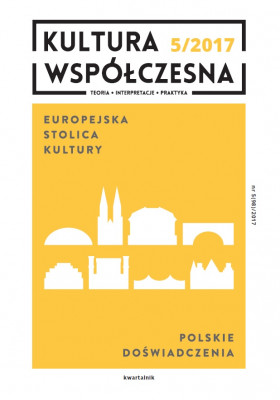Settings and search
European Capital of Culture – Polish experiences


Table of contents
I EUROPEAN CAPITAL OF CULTURE – POLISH EXPERIENCES
Paweł Kubicki
Introduction. Polish experiences of the European Capital of Culture program
Paweł Kubicki
Identity, memory and citizenship of cities in the context of the European Capital of Culture bidding process
Katarzyna Kajdanek
Experience and relatiogenicity of cultural events at the special weekends of the European Capital of Culture (ECC) Wrocław 2016
Ewa Banaszak
Awakening – the opening Ceremony of Wrocław 2016 European Capital of Culture Celebrations – unfinished ritual
Mateusz Błaszczyk
Image, pride, politics – local identity versus European Capital of Culture
Jacek Pluta
The consumption of culture – the case of European Capital of Culture Wrocław 2016
Łukasz Medeksza
A category of myth and the local development policies. Notes from a few projects in Lower Silesia between 2015 and 2017
Joanna Orzechowska-Wacławska
The Bilbao effect in Poland? Katowicka Strefa Kultury like Abandoibarra, basque-ness and silesia-ness in the revitalisation process
Anna Świętochowska, Krzysztof Gubański, Katarzyna Wojnar
The economy of prestige in metaculture circulations. Cultural circles and institutions of Wrocław in the aftermath of the European Capital of Culture
Mirosław Grochowski
Cultural potential of Wrocław in the spatial perspective
II REVIEWS
Jadwiga Zimpel
One-dimensional Pole and version 2.0
European Capital of Culture – Polish experiences
Introduction. Polish experiences of the European Capital of Culture program
- Paweł Kubicki
The article analyses the socio-cultural changes triggered by the European Capital of Culture 2016 bid. Results presented in this paper come from the research project: The effect of ECC. Searching for new urban narratives (Efekt ESK. W poszukiwaniu nowych miejskich narracji), which was funded by the Impart 2016 Festival Centre (grant no: K/KDU/000332), conducted by academic staff of the Institute
The article utilises results of the ECC Wrocław 2016 evaluation. Specifically, socalled special weekends were assessed to gauge the content and diversity of experiencing within cultural events, with a special emphasis on the aspect of multi-sensuality and relatiogenicity of such activities. The analysis is conducted is accordance to the renewed understanding of the participation in culture. The results show that the most significant feature of the culture experiencing is its influence on personal feelings and emotions, whilst the impact of the culture experiencing is less prominent on the cognitive trait concerned with personal reflections. Additionally, the content of experiencing varies between events and depends on attributes such as gender, age, education level, perceived financial condition and the overall rating of an event.
The Opening Ceremony resonated widely among the citizens of Wrocław, who rushed in great numbers to assembly sites and joined marches. However, it was not unequivocally described as a success. Citizens were divided in their assessment on the celebration and, yet, they shared the definition of situation. Why? What happened? What are we going to discover when we refer to the theory of interactive rituals? The article addresses these questions. The basis for the analysis is empirical material obtained from focus groups conducted with participants of the Awakening, together with inspirations coming from the theory of Randall Collins.
The article discusses the role of the European Capital of Culture organisation in the process of negotiating and creating a local identity of a city and its citizens. Social production of the local identity has been analysed as a process of the weaving of a triple helix linking the city’s social capital, citizen’s sense of pride and prestige, and forging it together into collective and individual benefits. The results of research on attitudes towards the idea of the European Capital of Culture presented here suggest that this event became an important device in the public discourse on the struggle for identity, which results in establishing rights to the city.
The aim of this paper is to analyse the participation in culture from a perspective of the urban consumption system and urban cultural policies. The participation in culture is interpreted, both in a descriptive way as a categorial collection of practices of spending leisure time, as well as from a functional point of view – an aspect of city-ness. This article examines results of the study employing the CATI research method, conducted with the participation of citizens of the Wrocław agglomeration. It explored the influence of the mass distribution of cultural events, linked to the European Capital of Culture celebrations, on widening the access to culture and on the aims of cultural policy.
Is there a Polish equivalent of post-developmentalism, which is a concept amongst development theories and practices contesting the whole idea of development in favour of the return to local traditions? How might it be expressed and what are examples of its possible usage? Is it possible for the analysis of urban myths and narratives to be translated into a development policy? What are new theoretical challenges of post-developmentalism? The paper explores these issues employing the example of three projects undertaken in Wrocław and Lower Silesia: Wrocław 2036/56 Social Foresight, the Wrocław 2030 Strategy and the City Reading. Two were conducted as a part of the European Capital of Culture 2016 celebrations. At the same time, the paper notes expressions of the cultural turn in Polish discussions on development. The article also draws attention to the eclecticism of the newest development strategies in the big Polish cities, which may be an indicator of a crisis in thinking about future – evidenced by the lack of bold visions.
This article is a contribution to the discussion on the cityscaping role of new institutions of culture created recently in Poland. The paper focuses on the Sphere of Culture (Strefa Kultury) in Katowice which was launched in 2015. The reference point is provided by Abandoibarra in Bilbao. The author compares two flagship revitalisation projects, undertaken in Katowice and Bilbao, containing the most emblematic buildings housing cultural institutions. The juxtaposition of Katowice and Bilbao is a result of the particular place of Bilbao, which for many years has been recognised as a blueprint for a successful revitalisation process, and a number of similarities of these two cities such as their industrial past, their pivotal positions in their capacity as regional mining centres, the stigma of industrial cities and their strong regional/national identity. The analysis shows that in the cultural dimension, both – the Sphere of Culture and Abandoibarra – are embedded in the local ethos and they endorse regional traditions; however, in terms of the social resonance created by institutions located there, these two places are diametrically different. The Sphere of Culture, contrary to Abandoibarra, due to its monofunctional character, its spatial separation from other city districts and promoting car journeys as a main transport mode, in its current form does not completely fulfil its potential and does not allow those establishments located there to become ‘propagators’ of city-ness.
This article examines the role of creativity and prestige in Wrocław in the context of the metropolitanisation of culture and events connected with the European Capital of Culture initiative. In order to provide a wide and multi-faceted perspective for the exploration of these phenomena, the economy of prestige approach was combined with the analysis of metaculture circulation processes. The results show that barriers to the rise of the economy of prestige in Wrocław include very little trust experienced by producers of culture towards systems of culture management, together with the centralisation evident in, for example, abstruse and puzzling staffing changes.
The paper touches upon the issue of placing institutions of culture and cultural events in the spatial dimension of Wrocław. A spatial survey was conducted, and shows a great degree of spatial diversification of the city’s cultural potential. Wrocław is divided into a cultural rich centre and poor suburbs. The city centre as a position of privilege, due to numerous transport links and institutions, is sharply contrasted with peripheral parts of the city, which serve mostly residential functions. This brings a conclusion that the lack of access, to even lower quality services, may lead to exclusion from the participation in culture.
